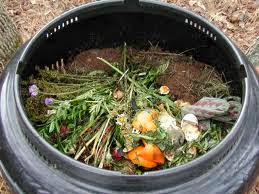Kitchen Garden Composting Tips:
The first thing you should do is find a shady spot in your yard. The area you choose should have soil that drains well where you can place a composting bin. You can make a bin or buy one. There are many commercial composters on the market. This will make it easier to get started by cutting back on construction time. Once you have picked your spot and have your bin in place you may begin the layering.
First add a 6-inch layer of dry (brown) organic matter, such as hay, old leaves, sawdust or straw to the bottom of the container. Next comes a 2 – 3 inch layer of fresh (green) organic matter: such as table scraps, manure, grass clippings, or even high nitrogen fertilizer like cottonseed meal, on top of the dry matter. Keep layering in this way while watering after each layer. Do this until you have reached 4 – 5 feet tall and have filled the container.
Any smaller and it won’t heat up the pile. Any larger and it could be difficult to manage.In two days you should mix the layers thoroughly. Using a pitchfork will make this easier. Particle size should be varied. Cover the pile with a tarp to keep rain away and to keep the pile moist in dry weather. If the pile gets too wet or too dry it won’t heat up properly. The pile will cook within a week. Now you need to keep it cooking. A hot pile is a happy pile. Keep your pile moist by watering periodically. Dig into the pile about 1 foot to see if it is moist. If not water thoroughly but as not to make it soggy.
Turn the pile when it cools down. Use your garden fork to remove the outside layers and put them aside. Remove the inside layers into a separate pile and switch. Place the outside layers in the center of the new pile and place the inside layers along the outside of the new pile.
Loosen any matted clumps. Let it cook again and when it cools repeat the process.Make sure your pieces of material that you are adding are not too big. This will slow down the decomposition and possibly halt it all together. Shredding leaves helps to feed the compost faster. When your compost is dark in color, crumbly and smells earthy without a strong ammonia or sour smell, it is ready to enter into the garden.
Thanks for Visiting www.womenspage.in





 Posted in:
Posted in: 










